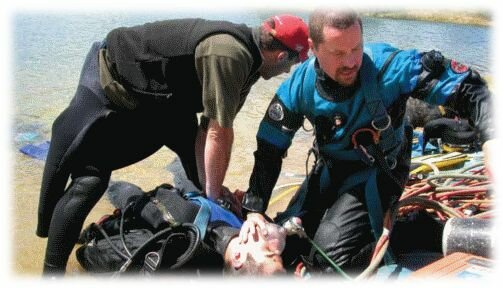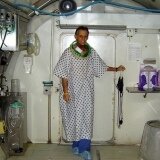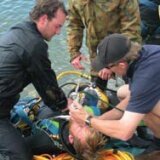Arterial Gas Embolism (AGE)

Embolism in medical terms is a condition which describes objects called emboli, in this case they are gas bubbles, formed in a human body which enter the circulatory system.
Emboli (gas bubbles) can block arterial or venous blood flow. Another harming effect of AGE includes platelets clumping. This leads to the obstruction of blood vessel walls and leaking of fluids into surrounding tissues. The resulting swelling further reduces tissue blood flow.
A condition associated with this serious problem often referred to as either Arterial Gas Embolism (AGE) or Air Gas Embolism. Play the short video below to visualize AGE formation...
Gas bubbles (emboli) leading to AGE can be formed in the body by several possible reasons, some of them are listed below:
- During rapid ascent in divers in divers after breathing compressed gas at depth
- During normal ascent in divers with lung pathology, e.g. asthma, bullous disease, etc...
- Pulmonary Barotrauma as a result of blast injury in or out of water
- Chest tube placement
- Bronchoscopy
- Penetrating chest trauma
- Mechanical ventilation
- Accidental intravenous air injection
AGE - Possible Outcomes
Compromised blood circulation promoted by AGE ("the bends") results in poor oxygen delivery to the affected body areas. Possible outcomes of AGE may be permanent with severe impact on the quality of life and be disastrous.
AGE can result in irreversible physical disabilities and in severe cases be fatal. The damage can affect vital organs like brain (cerebral embolism), heart or lungs, can impair the vision, paralyze the limbs and lead to a total disability.
Symptoms of AGE
- Extreme fatigue
- Dizziness
- Joint pain
- Hearing loss
- Numbness
- Tingling
- Skin rash
- Paralysis
- Weakness of arms or legs
AGE Treatment
Hyperbaric Oxygen Therapy remains the definitive treatment of choice for AGE. A review of numerous cases of cerebral embolism and AGE reveals superior outcomes with the use of Hyperbaric Oxygen Therapy comparing to non-recompression treatment. Only Hyperbaric Oxygen Therapy if applied in time can immediately restore cellular oxygenation levels correcting blood flow in deprived sites and tissue swelling.
The rationale behind the AGE treatment is that increased pressure inside Hyperbaric Chamber reduces bubbles size and forces the gas inside the bubbles back into a physical solution, the blood and plasma. Higher oxygen levels create a large diffusion gradient for inert gas to leave bubbles and thus restoring normal blood flow. With restored blood flow, poorly oxygenated tissues start receiving more oxygen, and local edema gradually subsides. Hyperbaric Oxygen Therapy reduces ischemic-reperfusion injury.
Usually AGE is treated according to US Navy Treatment Table 6A applying the pressure of 6ATA. If after initial recompression the symptoms of AGE still present, another deeper recompression may be required.
During decompression in Hyperbaric Chamber in cases when AGE was caused by Pulmonary Barotrauma, a complication may occur with coexisting Pneumothorax which can develop into Tension Pneumothorax. Such patients should be closely monitored during Hyperbaric Treatment. For patients treated in a Monoplace Hyperbaric Chamber a chest tube insertion before the Hyperbaric Oxygen Treatment can be considered. In cases of AGE with co-existing Pneumomediastinum no specific therapy is generally required and the condition is usually corrected by Hyperbaric Oxygen Treatment.
An injured diver is helped from a Royal Navy Sea King Helicopter on arrival at Millport on the Island of Cumbrae for treatment at the Hyperbaric Chamber at the islands University Marine Biology Station.

Photo courtesy of "Sea Pigeon"
Further Reading...
-
-
-
- Hyperbaric Oxygen Treatment : The Last Frontier. Philip B James MB ChB, PhD, DIH, FFOM
- Treatment of Diabetic Ulcer Wounds By Hyperbaric Oxygenation. Review Of Scientific Trials Concerning Diabetic Foot Ulcers
- Retinopathy of prematurity may be prevented by the intermittent use of higher dosages of oxygen.
- Hyperbaric Oxygen Treatment (HBOT): oxygen transport to ischemic / hypoxic tissues is explained in this article by analyzing the physics and physiology of oxygen.
- Why Hyperbaric Oxygen Therapy is the most natural way of letting the body to heal itself...
- Aerobic Cellular Respiration Overview...
- TRCS - Transportable Recompression Chamber System For Emergency Evacuation And Treatment.
- Acute Brain and Cardio-Respiratory Dysfunction After Blast/Blunt Injuries: The Life-Preserving Effects of Hyperbaric Oxygenation...
- Diseases of the Respiratory System.
- Oxygen Toxicity Overview
- Characteristics for Autism Spectrum Disorders and diagnostic criteria.
- Near Drowning Overview.
- HBOT: historical perspective and physical basis...
- Hypoxia is sometimes dangerous, life-threatening state for our cells and tissues. Learn about hypoxia symptoms, causes and types...
- SPECT - Single Photon Emission Computed Tomography Emission Computed Tomography, a type of nuclear imaging showing how blood flows to tissues of organs.
- Air Embolism, the definitive treatment of which remains Hyperbaric Oxygen Therapy (HBOT).
- Carbon Monoxide Poisoning, recovery among patients treated with Hyperbaric Oxygen appears to be improved beyond that expected with ambient pressure supplemental oxygen therapy...
- Cyanide poisoning in combination with carbon monoxide poisoning frequently occur simultaneously in victims of fires, smoke inhalation, military operations and industrial accidents.
- For Gas Gangrene (Clostridial Myonecrosis) and Clostridial Myositis or spreading clostridial cellulitis with systemic toxicity the preferred treatment is a combination of Hyperbaric Oxygen Therapy (HBOT), Surgery, and Antibiotics.
- Crush injury is directly associated with trauma while skeletal muscle compartment syndromes arise from ischemia, venous outflow obstruction, exertion, external compression as well as trauma.
- Hyperbaric Oxygen Treatment Center At Elisha & Rambam Hospitals
- With Compartment Syndrome, Hyperbaric Oxygen Therapy (HBOT) when used as an adjunct to a surgery and antibiotics shows promise as a way to decrease complications and morbidity.
- Decompression Sickness - definition, symptoms and treatment of choice...
- Non healing wounds like diabetic foot ulcers can benefit from HBOT.
- Exceptional Blood Loss Anemia and Hyperbaric Oxygen Therapy (HBOT) as adjunctive therapy to win the time for survaval...
- Subdural empyema and other intracranial or cerebral abscesses are usually caused by anaerobic bacteria (bacteria that function optimally in low oxygen concentrations)...
- Necrotizing wound infection may result from either a single strain or a mixed population of bacteria, typically occurring after trauma, surgery, and/or around foreign bodies...
- Refractory osteomyelitis is a chronic osteomyelitis which often does not responded to the treatment administrated. HBOT directly kills or inhibits the growth of infection also augmenting the efficacy of bacterial killing by antibiotics.
- Tissue necrosis, bone necrosis and other radiation injuries as a delayed complications of radiation exposure...
- Skin graft survive when oxygen and nutrients diffuse into them from the underlying wound bed...
- Thermal Burns: HBOT when used as an adjunct in a comprehensive program of burn care, can significantly improve morbidity and mortality, reduce length of hospital stay, and lessen the need for surgery.
- The appearance of early symptoms of autism is a reason to have a child evaluated by a professional specializing in Autism Spectrum Disorders. See the autism symptoms checklist...
- Several autism types have been defined along the autism spectrum, differing in the severity of the symptoms and total disability and in the combinations of autistic impairments with other disabilities.
- Autism And Vaccinations: Clear Answers & Smart Advice About Your Babys Shots
- Portable Hyperbaric Chambers and HBOT should become an important player in humanitarian efforts in support of casualties sustained by individuals from natural disasters, battlefields and terrorist acts...
- Portable Hyperbaric Chambers SOS Hyperlite
- In spite of a number of existing Autism treatments, there are no miracle autism cures. For many realistic parents striving to help their autistic kids to feel less frustrated, communicate, perform and feel better, one of the crucial questions is what is the correct course of the autism treatment?













